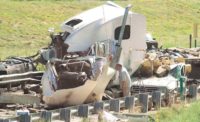Jobsite Fatalities
Fewer NYC Construction Deaths as Safety Law Awaits Governor's Signature
Contractors seek changes before final approval

Union construction workers demonstrate in Manhattan in 2017 to protest worker deaths.
Photo by Michael Nigro/Sipa via AP Images
The hoped-for progress in New York City construction safety is coming too late for laborer Jose Fortina Armenta Hernandez. At 8:37 a.m. on May 27, 2021, while jackhammering a roof section on a Brooklyn building, the section on which Armenta stood gave way and he fell 60 ft. When last year his family sent his body from New York City to Mexico to be buried, they used a GoFundMe page to raise money for the laborer's funeral.
His death came at a time when New York City seemed to be turning a statistical corner as far as cutting annual fatal construction accidents, and a new safety law set to be signed by N.Y. Gov. Kathy Hochul may bring more progress.
But safety advocates aren't celebrating yet, and union and small minority- and women-owned contractors are uncomfortable with key wording in the law.
After three years of consistent increases, partly because of the pandemic slowdown and stepped up city safety enforcement, 13 construction workers died on the job in 2020, compared to 24 the years before.
ENR sources and U.S Bureau of Labor Statistics
Partly because of the pandemic slowdown and stepped-up city safety enforcement, after three years of consistent increases, 13 construction workers died on the job in 2020, compared to 24 the year before. Construction fatalities had fallen for five consecutive years in all of New York State, from 55 in 2019 to 41 in 2020, according to the U.S. Bureau of Labor Statistics.
This year, a much-anticipated new law promises to dramatically increase monetary penalties against construction employers found guilty of criminal safety lapses.
Supporters say it will help drive construction accidents and deaths still lower. After approval by the state legislature in the spring, Carlos' Law, named for 22-year-old Carlos Moncayo, who died in a 2015 trench collapse, awaits only Hochul's signature to become law.

A GoFundMe page organized last year for the family of Jose Armenta, who died in a construction accident.
But partly because of the still stubbornly high number of deaths, safety advocates are less than joyous.
"New York should be a national leader in workers safety," says Charlene Obernauer, executive director of the New York Committee for Occupational Safety & Health (NYCOSH), a nonprofit organization that performs safety training and advocates for worker safety.
"But the data reveal that we continue to lead the nation in construction worker fatalities, despite COVID-19 shutdowns," she said in a statement that accompanied the organization's annual New York City construction safety report.
New York City's Dept. of Buildings, which uses a different method of counting fatalities, is more optimistic.
It noted in its annual report for 2021 that for a third year in a row building construction-related incidents, injuries and deaths declined, "even as construction activity has rebounded from a pandemic-related low in 2020." In 2019, the city counted 13 construction-related fatalities, with eight in 2020 and nine in 2021.
Smaller, open-shop contractors and smaller projects account for the majority of New York City building construction deaths, with most due to falls and struck by/crushed accidents. Immigrant workers, many of them undocumented, are often the victims.
New York City's Dept. of Buildings 13 months ago adopted a zero-tolerance approach to safety violations and last year began inspection "sweeps" of jobsites to enforce it.
New City Construction Safety Rules
The city council also adopted five new laws proposed by the buildings department, including licensing all general contractors, requiring licenses for all superintendents and safety professionals working on building projects seven-to-nine stories tall, tightening rules for light cold-formed steel construction and prohibiting the use of stand-off brackets for C-hook suspended scaffolds.
NYCOSH notes that while fatalities are down, the total number of OSHA inspections are down, too. The organization, which is partly union-funded, recommends measures including required training for construction workers, keeping New York's Labor Law 240 (commonly known as the scaffold law and which presumes liability by employers and gives workers the right to sue over injuries), doubling OSHA's budget and expanding criminal prosecutions of contractors.
Carlos' Law will help, too, says NYCOSH. It will expand the potential financial penalty against an employer convicted of a felony for endangering the welfare of a worker from its current cap of $10,000—"a trivial amount," according to NYCOSH—to a range of between $500,000 and $1 million, according to an analysis by the law firm Couch White LLP. Penalties for misdemeanors, currently capped at $5,000. will range from $300,000 to $500,000.
The pending law emphasizes the supervisor's role in endangering the welfare of a worker, and in the text, a supervisor is broadly defined to include individuals and employers of different kinds.
Union construction employers and minority and women contractors are hoping Gov. Hochul slightly alters the wording.

A page from the New York City Dept. of Buildings annual report describes the accident that killed Jose Armenta.
The Building Trades Employers Association, which represents union contractors in New York City, the local chapter of the National Association of Minority Contractors and the Women Builders Council are asking Hochul to make changes.
In a letter to the governor, the groups ask her to remove the minimum amounts because they say minimums would harm small, minority and women-owned contractors. They ask Hochul to insert the term "reckless" as the standard for the minimum fine. They also want Hochul to change wording so the law applies only to "serious" injury, not just injury.
"The changes we're asking the governor to make are minimal and we're trying to make the bill better and fairer," says Louis J. Coletti, CEO of the Building Trades Employers Association.
"Our objections are not designed to undermine safety," he adds. "We believe that on every job, whether union or nonunion, workers deserve to go home" in the same good health that they started the day.
Meanwhile, federal safety officials still have business to settle with Armenta's employer.
The U.S Occupational Safety and Health Administration has proposed $374,000 in penalties against Richmond Construction related to the accident and subsequent inspections. The company had previously not commented on the accident and OSHA records show that it is contesting the penalties.
OSHA penalties are usually reduced under a settlement, negotiated between attorneys for the company and OSHA, where the employer agrees to make changes in its future practices.





